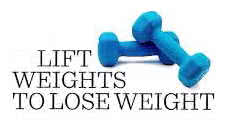Exciting New Research: Weight Training for Weight Loss

Ground-Breaking Exercise & Health Resources
Many personal trainers have clients who are hesitant to pump iron while they're trying to lose weight because they're afraid that they'll actually gain. Nowadays, although we understand that it is body composition, not body-weight, that tells the story, most people still go by the
scale when measuring the success or failure of a weight-loss program.
Research continues to document the benefits of resistance training as an adjunct to weight-loss programs. The two main advantages include the calories burned during the exercise and the elevated metabolism that gains in muscle mass bring. Restricting calories alone generally leads
to losses of lean body mass, or muscle, as well as bodyfat, while the combination of a diet and aerobic exercise helps to limit the muscle losses that come from dieting. If you add weight training to the mix, however, you may actually gain in lean body mass, which will result in
a faster-burning metabolism.
Since muscle is metabolically more active than fat, it requires significantly more energy per day for upkeep. This translates to the fact that the more muscle you have, the higher your metabolism is and the more calories you burn even before you start exercising. In fact, estimates
of calorie requirements for muscle range from 30 to 50 per pound of muscle per day.
So even if your goal is weight loss, you're better off focusing on lean weight and fat weight rather than overall bodyweight, and if you incorporate resistance training into your weight-loss program, you'll help keep your metabolism up and your calorie balance negative.
Off-season versus On-season Workouts
Elite athletes from professional football and hockey players to marathon runners, cyclists and tri-athletes incorporate resistance training into their off-season and contest-season conditioning programs.Even so, these athletes don't do nearly as much weight work as bodybuilders and other trainees who pump iron to increase size and improve appearance do. Most athletes who are not bodybuilders work out solely with an eye to improving the specific performance of their sports. To that end they must incorporate weight work into their overall programs in a way that prevents them from becoming over trained, For optimal results it is generally recommended that these athletes limit their weight sessions in both the off- and competitive seasons to three per week and spend the remainder of their training time doing cross-training activities in the off-season and sport-specific and skill-training activities in the pre contest and contest seasons.
Such athletes frequently drop weight training to twice per week during the early competitive season and eliminate it altogether as the season progresses, depending on the sport and the athlete.
Many endurance athletes stop pumping iron once they begin their preseason training, particularly their leg training. For athletes who use their legs to a great degree in their sports reducing leg work on the weights while continuing to work their upper bodies enables them to keep their legs fresh for sports performance and limit fatigue and overtraining. Most of the strength and power gains made during the off-season can be maintained for some time, particularly if an athlete trains at high intensity.